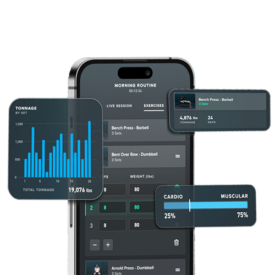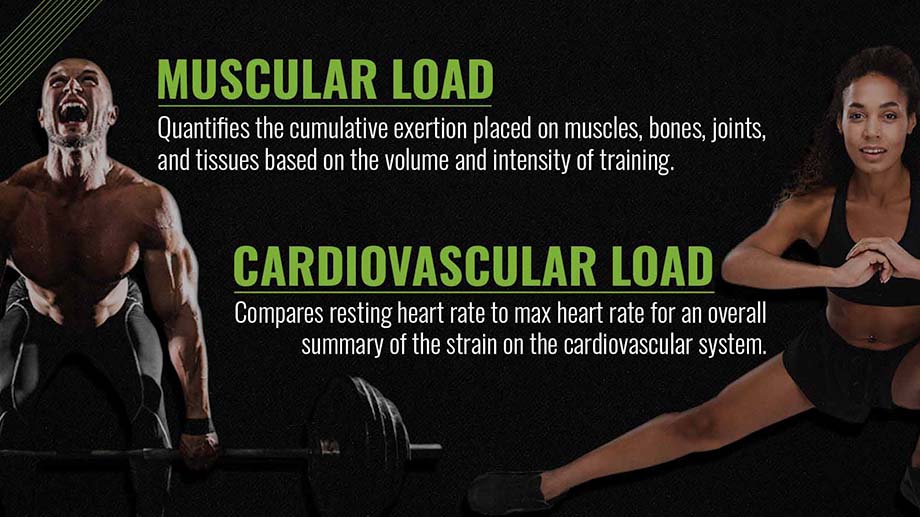Take a look at yourself in the mirror towards the end of your next workout. If everything went according to plan, your heart should be thumping in your chest, there should be sweat pouring from your brow, all while blood swirls and pools in your muscles: The hallmarks of hard work in the gym.
While effort may be superficially obvious, it doesn’t always align perfectly with what’s going on under the hood. Despite what your body tells you, you may have more to give during your workouts.
If you’re trying to build muscle or boost your strength, you need to know when you’ve hit your limits — and, more importantly, when you haven’t. You need feedback in the form of real, actionable information about the state of your muscles and the amount of strain they’re really under. And with the Strength Trainer feature from WHOOP, that’s exactly what you’ll get.
As a revolutionary update to WHOOP’s iconic wearable, Strength Trainer helps you decide when you should step on the gas or pump the brakes by providing more comprehensive data than ever before. That means you won’t have to guess how hard your lift was — you’ll get all of that information (and more) delivered right to you.

Take advantage of a free one-month trial of WHOOP, which includes full access to everything the app has to offer, along with a WHOOP 4.0 device.
What Is Muscular Strain?
All physical activity applies stress to your body in some form, but the type of activity you perform will tax certain areas more than others. A long-distance run challenges your cardiovascular system and your heart’s ability to pump blood and recycle waste products; yoga or gymnastics tests your proprioception and soft tissue elasticity.
When you hit the gym for a heavy strength training session, your muscles bear the physical load of the weights you lift, your connective tissues resist tension and torque, and your circulatory system works double-time to provide usable nutrients as your muscles lengthen and contract. These factors, in combination, add up to muscular strain.
Why It Matters
When it comes to making gains, you need to train hard, but not too hard. Undershoot the amount of stress you apply to your body and it won’t have any reason to adapt. However, repeatedly pushing yourself to (and beyond) failure, inducing more muscular strain than you can handle, probably won’t result in better gains but will dampen your ability to recover. (1)
Proper training is all about hitting that sweet spot. But here’s the rub: most of the “tried-and-true” methods of assessing muscle strain amount to guesswork. The percentages of your one-rep max you follow in your program may not be truly accurate, depending on the conditions under which you tested your strength in the first place.

The RPE (that’s “rate of perceived exertion”) scale works pretty well, but it still relies on perception. It’s subjective. With your heart pounding in your ears after a hard set of squats, can you really accurately judge how close you were to failure?
WHOOP’s Strength Trainer cuts through the static and takes the guesswork out of the equation so you don’t leave your gains to chance. Here’s how the Strength Trainer assesses muscular strain.
What Is the WHOOP Strength Trainer?
Strength Trainer, WHOOP’s latest update to its fitness wearable, was developed after thousands of hours of research as a means of quantifiably measuring the impact of strength training on the human body.
Thus far, traditional fitness devices have done an adequate job of providing data on heart rate, step count, and blood pressure. This information is valuable but doesn’t actually tell you much about how hard your muscles are working in the gym. WHOOP uses advanced biometrics and sensor technology to bridge that gap.
How It Works
The Strength Trainer analyzes four distinct components of fitness and combines them into an all-encompassing Strain score. Your Strain score will tell you how close you are to your limits and whether you can keep pushing. Here are the four facets of muscular strain:
Muscular Load
Each exercise you perform applies a certain amount of torque and tension to your musculoskeletal system. For example, squats and deadlifts may involve similar muscles, but your leverages and the resistance profile of each movement differ dramatically. When it comes to muscle growth, research shows that mechanical tension may be the most important factor in eliciting hypertrophy (muscle growth). (2)
Strength Trainer compiles biomechanical data during your workouts, analyzing the movement profile of your favorite exercises and the impact they have on your body. It doesn’t just recognize that you’re lifting; it knows what you’re doing, how you’re doing it, and how hard it is.
Cardiovascular Load
All strength training movements — even a one-rep-max test — challenge your cardio to some degree. The more reps you perform, or the longer your range of motion, the more blood and oxygen you need to finish your set.
Strength Trainer monitors your heart rate to assess how much you’re demanding of your cardio system during a specific exercise and then weighs that data against your resting heart rate to contextualize the cardiovascular load.
Tonnage
You can think of tonnage as cumulative volume; it’s a measure of how much actual work you do. WHOOP’s Strength Trainer calculates tonnage by multiplying the weight lifted by reps and sets performed on a given exercise.
Say you’re hitting up a bench press workout and you do three sets, each with 10 repetitions and 185 pounds on the barbell. Your cumulative tonnage for that exercise would be 5,550 pounds.
It also factors in your current body weight to measure not only your absolute work capacity but your relative strength capabilities as well.
Intensity
Muscular power is the result of both strength and speed. The Strength Trainer monitors how explosively you lift a weight on a given exercise with an accelerometer and gyroscope. This provides feedback about your athletic readiness and ability to generate explosive force.
Development of the WHOOP Strength Trainer
On the surface, physical fitness is simple enough: Move a weight from here to there or log a few laps around the track. But behind the curtain, your body operates as a series of dynamic, intricate systems that enable your performance. WHOOP is the industry leader in analyzing those systems and converting how they operate into useful information, and the Strength Trainer is their latest leap forward in the science of fitness.
Collegiate coaches and Olympic athletes alike rely on velocity-based training (VBT) to improve force production, a key marker of high-level athletic performance. In 2021, WHOOP acquired PUSH — a VBT coaching platform.
Thousands of hours of collaborative research followed, during which WHOOP and PUSH analyzed athletes performing all manner of exercises. The result? Over 10,000 repetitions’ worth of data in the initial validations alone.
By integrating that data (and PUSH’s algorithms) into their state-of-the-art hardware, WHOOP added a new dimension to their existing Strain score. Users now have more actionable performance information at their fingertips — or rather, around their wrists — than ever before.
Benefits of the WHOOP Strength Trainer
Nothing brings peace of mind to your fitness journey like removing ambiguity from the equation. The more you know about how your body responds to your workouts, the better those workouts will be. Less time wasted equals more gains made.
Know (and Surpass) Your Limits
Instead of relying on observation or guesswork about your fatigue levels in the gym, WHOOP’s Strength Trainer feature provides clear and precise data immediately following your workouts. Feedback regarding your levels of cardiovascular and muscular strain can help you make informed, productive decisions for your routine moving forward.
If your goal is to increase the muscular strain of your workouts, you can just look through Strength Trainer’s post-workout report to determine the right exercises for you to increase your weights and reps. By tracking your tonnage every session, you can plainly see how much stronger you’ve gotten week-to-week as you add more weight to your routine.
Real-Time Data
If you’re in the middle of a grueling workout, the last thing you want to do is throw off your rhythm. Common methods of performance monitoring, like filming your sets or asking the opinion of a coach, are great, but they take time and are far more cumbersome than simply checking your wrist.
WHOOP’s Strength Trainer technology is also a feedback loop: The more people use it, the more it learns and can return ever-sharper biofeedback. This means that your Strength Trainer grows and progresses with you in real time.
Move More (and More Often)
Wearables like WHOOP do more than just inform you about the quality of your exercise. In fact, simply strapping one on may help you exercise more. Some researchers have analyzed the behavior of individuals who wear fitness devices.
Notably, the data show that you may end up increasing your physical activity levels just by virtue of having a wearable like WHOOP on your wrist throughout the day. (3)(4) You might find the additional information Strength Trainer provides motivating enough to get up for a workout that you’d otherwise skip.
Changing the Game
When it comes to the WHOOP Strength Trainer, knowledge is, quite literally, power. You’re probably quite familiar with the concept of muscular strain and how it impacts your performance, but it can be difficult to trust your gut or approach fatigue objectively.
Strength Trainer makes everything clear, quantifiable, and, most importantly, actionable. WHOOP’s latest iteration of wearable fitness technology may be its greatest yet, but Strength Trainer is far from the final destination.
WHOOP plans to implement a whole host of user-friendly features, from workout sharing to weight tracking. It also earns points for being self-perpetuating; the more data Strength Trainer accumulates, the more articulate and robust its algorithms become. WHOOP ensures that you, like your wearable, will be a little bit better than yesterday. To try Strength Trainer for yourself, head to WHOOP’s website for more.

Take advantage of a free one-month trial of WHOOP, which includes full access to everything the app has to offer, along with a WHOOP 4.0 device.
Frequently-Asked Questions
WHOOP’s Strength Trainer feature is focused on making the unknowable — how much muscular strain you’re accumulating over the course of a workout — knowable, but that’s not all. If you aren’t sold just yet, check out these common questions for more information.
What happens to my existing Strain scores on my WHOOP?
Strength Trainer doesn’t apply retroactively yet. WHOOP is hard at work developing backward compatibility in future iterations of the feature. That said, current and future Strain scores may provide better information anyway, since Strength Trainer accounts for both musculoskeletal and cardiovascular load.
Do I need to use the Strength Trainer to understand my workouts?
Not necessarily, but it will certainly help. Strength Trainer offers you more specific, actionable information during your workouts. This can help you assess your levels of fatigue or determine what weights are appropriate for you, rather than trying to self-assess or depend on an ambiguous method like RPE.
How do I create a workout on Strength Trainer?
You have two options. You can select from a library of over 200 common strength training movements to build your own workout. Strength Trainer will guide you through each step and track your cadence. Once you’re done, the Activity tab will report on your cardiovascular and muscular load.
Or, you can select from 15 (with more to come) pre-built workouts. These workouts were developed by top-class athletes and trainers, and each comes with a specific focus: Think power development, muscle growth, or work capacity.
References
- Nóbrega, S. R., & Libardi, C. A. (2016). Is Resistance Training to Muscular Failure Necessary?. Frontiers in physiology, 7, 10.
- Schoenfeld B. J. (2010). The mechanisms of muscle hypertrophy and their application to resistance training. Journal of strength and conditioning research, 24(10), 2857–2872.
- Ferguson, T., Olds, T., Curtis, R., Blake, H., Crozier, A. J., Dankiw, K., Dumuid, D., Kasai, D., O’Connor, E., Virgara, R., & Maher, C. (2022). Effectiveness of wearable activity trackers to increase physical activity and improve health: a systematic review of systematic reviews and meta-analyses. The Lancet. Digital health, 4(8), e615–e626.
- Tang, M. S. S., Moore, K., McGavigan, A., Clark, R. A., & Ganesan, A. N. (2020). Effectiveness of Wearable Trackers on Physical Activity in Healthy Adults: Systematic Review and Meta-Analysis of Randomized Controlled Trials. JMIR mHealth and uHealth, 8(7), e15576.
Credit: Gorodenkoff / Shutterstock
